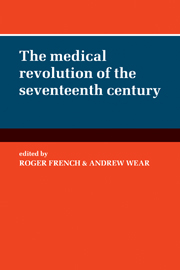Book contents
- Frontmatter
- Contents
- List of contributors
- Acknowledgements
- Introduction
- 1 Medicine, religion and the puritan revolution
- 2 Harvey in Holland: circulation and the Calvinists
- 3 The matter of souls: medical theory and theology in seventeenth-century England
- 4 Mental illness, magical medicine and the Devil in northern England, 1650–1700
- 5 Passions and the ghost in the machine: or what not to ask about science in seventeenth- and eighteenth-century Germany
- 6 Thomas Sydenham: epidemics, experiment and the ‘Good Old Cause’
- 7 The medico-religious universe of an early eighteenth-century Parisian doctor: the case of Philippe Hecquet
- 8 Isaac Newton, George Cheyne and the Principia Medicinae
- 9 Physicians and the new philosophy: Henry Stubbe and the virtuosi-physicians
- 10 The early Royal Society and the spread of medical knowledge
- 11 Medical practice in late seventeenth-and early eighteenth-century England: continuity and union
- Index
11 - Medical practice in late seventeenth-and early eighteenth-century England: continuity and union
Published online by Cambridge University Press: 05 January 2012
- Frontmatter
- Contents
- List of contributors
- Acknowledgements
- Introduction
- 1 Medicine, religion and the puritan revolution
- 2 Harvey in Holland: circulation and the Calvinists
- 3 The matter of souls: medical theory and theology in seventeenth-century England
- 4 Mental illness, magical medicine and the Devil in northern England, 1650–1700
- 5 Passions and the ghost in the machine: or what not to ask about science in seventeenth- and eighteenth-century Germany
- 6 Thomas Sydenham: epidemics, experiment and the ‘Good Old Cause’
- 7 The medico-religious universe of an early eighteenth-century Parisian doctor: the case of Philippe Hecquet
- 8 Isaac Newton, George Cheyne and the Principia Medicinae
- 9 Physicians and the new philosophy: Henry Stubbe and the virtuosi-physicians
- 10 The early Royal Society and the spread of medical knowledge
- 11 Medical practice in late seventeenth-and early eighteenth-century England: continuity and union
- Index
Summary
INTRODUCTION
To argue that medicine did not change, or changed slowly, in the second half of the seventeenth century and the beginning of the eighteenth century may appear perverse. After all, as the chapters in this book demonstrate, change was taking place all around medicine and moreover, the institutions and groupings within medicine were changing. But what of medical practice? Here also the different medical sects, the Galenists, Paracelsians, empiricists, chemists, iatrochemists, iatromathematicians had their own particular theories and remedies. Yet there was underlying unity that implied a lack of change both in medical theory and practice. This unity was the consequence of a need by medical practitioners to be understood by patients, to relate to their expectations and hence to attract their trade. Commerce, in other words, could transcend apparent theoretical or institutional differences.
MEDICAL THEORY
It appears obvious that medicine changed radically in this period. The chemical, corpuscular, experimental and mathematical developments in science came to be united in different ways to provide new theoretical bases for medicine. The non-mathematical, non-mechanical, qualitative–humoral system of the ancients seems to have been replaced.
- Type
- Chapter
- Information
- The Medical Revolution of the Seventeenth Century , pp. 294 - 320Publisher: Cambridge University PressPrint publication year: 1989
- 11
- Cited by



